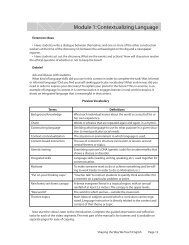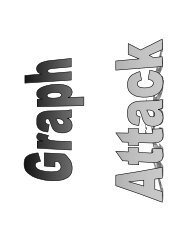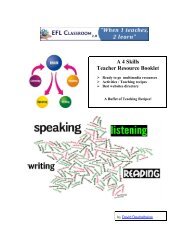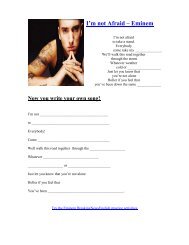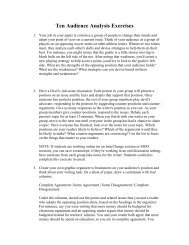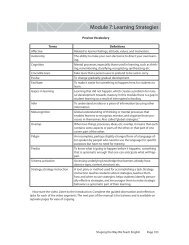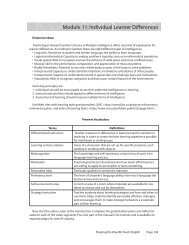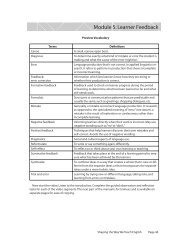Approaches to Language Teaching: Foundations - EFL Classroom 2.0
Approaches to Language Teaching: Foundations - EFL Classroom 2.0
Approaches to Language Teaching: Foundations - EFL Classroom 2.0
You also want an ePaper? Increase the reach of your titles
YUMPU automatically turns print PDFs into web optimized ePapers that Google loves.
<strong>Approaches</strong> <strong>to</strong> <strong>Language</strong> <strong>Teaching</strong>: <strong>Foundations</strong><br />
For more ideas for pho<strong>to</strong>s, consult local newspapers, posters, billboards, brochures, pho<strong>to</strong>s, and<br />
magazines. On the Web, you may also find pho<strong>to</strong> galleries, news sites, and image search engines such<br />
as the following <strong>to</strong> be useful sources of images:<br />
Flickr Pho<strong>to</strong>s<br />
Google Image Search<br />
Smithsonian Institution Pho<strong>to</strong>graphic Services<br />
http://www.flickr.com/pho<strong>to</strong>s/<br />
http://www.google.com<br />
http://pho<strong>to</strong>2.si.edu<br />
Preview Vocabulary<br />
Terms<br />
Accommodate<br />
Collaborative Learning<br />
Cooperative Learning<br />
Deductive (reasoning)<br />
Describe, Interpret, Evaluate<br />
process<br />
Inductive (reasoning)<br />
Jigsaw activity<br />
Praxis<br />
Rubric<br />
Sockeye salmon<br />
Definitions<br />
To allow for; consider the educational or emotional needs of.<br />
Collaborative Learning is a method of teaching and learning in<br />
which students team <strong>to</strong>gether <strong>to</strong> explore a significant question<br />
or create a meaningful project. A group of students discussing a<br />
lecture or students from different schools working <strong>to</strong>gether over<br />
the Internet on a shared assignment are both examples of collaborative<br />
learning.<br />
Cooperative Learning is a specific kind of collaborative learning.<br />
In cooperative learning, students work <strong>to</strong>gether in small groups<br />
on a structured activity. They are individually accountable for<br />
their work, and the work of the group as a whole is also assessed.<br />
Taking a known idea or theory and applying it <strong>to</strong> a situation.<br />
A step-by-step interpretation process from interculturist Stella<br />
Ting-Toomey. It’s a way <strong>to</strong> slow down the response and reaction<br />
<strong>to</strong> new ideas or experiences, and <strong>to</strong> view them with a more open<br />
mind.<br />
A type of type of reasoning which involves observing patterns<br />
and using those observations <strong>to</strong> form an idea or make generalizations.<br />
A group work activity in which different members of the group<br />
have different tasks related <strong>to</strong> the same <strong>to</strong>pic. Students perform<br />
the tasks individually, then come back <strong>to</strong> the group <strong>to</strong> put the<br />
information or pieces <strong>to</strong>gether “jigsaw puzzle” style.<br />
A cus<strong>to</strong>mary practice or conduct.<br />
A scoring guide or template for giving feedback on student work<br />
and performances.<br />
A large fish with reddish meat.<br />
Now start the video. Listen <strong>to</strong> the introduction. Complete the guided observation and reflection<br />
tasks for each of the video segments. The next part of the manual is for trainees and is available on<br />
separate pages for ease of copying.<br />
Page 39<br />
Shaping the Way We Teach English
Module 4: Pairwork / Groupwork<br />
Module 4, Pair and Group Work<br />
Module Focus<br />
The focus in this module is on pair and group work. Pair and group work incorporates principles<br />
and themes from the Cooperative Learning and Collaborative Learning theoretical frameworks. In<br />
the video, you will look at some real classroom examples of this. You can use Ting-Toomey’s Describe,<br />
Interpret, Evaluate process <strong>to</strong> analyze what is happening with pair and group work in these classes.<br />
Video Segment #1, Pairs and Groups, Example A: Observation Guide<br />
[Read before viewing.]<br />
Observe the following class. Look for answers <strong>to</strong> the questions...<br />
1. How is the class organized (chairs, tables, desks)?<br />
2. How are the pairs and/or groups organized?<br />
3. What kinds of interactions occur between the groups and teacher, and within the groups themselves?<br />
Use the Describe, Interpret, Evaluate (steps 1 through 3) process <strong>to</strong> analyze the class events.<br />
Reflection<br />
[Read and answer after viewing.]<br />
1. What were your results with the Describe, Interpret, Evaluate process? Was there anything about<br />
the class that surprised you or was new for you?<br />
2. In what sequence did the activities occur, and why?<br />
3. What kind of learning do you think <strong>to</strong>ok place among students during the small group work?<br />
During the contest (game)?<br />
4. If you are working with a partner or group, in what ways were your results similar <strong>to</strong> other participants’<br />
results? In what ways were they different? Did you make any revisions <strong>to</strong> any of your steps<br />
after comparing your results <strong>to</strong> theirs?<br />
Video Segment #2, Pairs and Groups, Example B: Observation Guide<br />
[Read before viewing.]<br />
1. What is the role of the teacher? The students?<br />
2. What kind of group management techniques do you notice?<br />
3. What is the purpose of using group work in this case?<br />
Reflection<br />
[Read and answer after viewing.]<br />
1. What kinds of direction did the students give each other? Did you notice any examples of student<br />
self-corrections?<br />
2. What kinds of spontaneous communication <strong>to</strong>ok place between students?<br />
3. What were some of the pros and cons of an all-class writing event like this one?<br />
Module 04 Summary Discussion<br />
1. This module showed examples from a class of younger learners and from a university-level class.<br />
Shaping the Way We Teach English Page 40
<strong>Approaches</strong> <strong>to</strong> <strong>Language</strong> <strong>Teaching</strong>: <strong>Foundations</strong><br />
Which of the activities could work well for both age groups? What kinds of adjustments or adaptations<br />
might be necessary?<br />
2. What role does assessment play in the classroom activities that you saw? How might the students’<br />
performance affect the future lessons that the teacher plans for these classes?<br />
3. The focus in the questions up <strong>to</strong> this point has mainly been on what you notice happening in<br />
the foreground of the scenes. Watch the classes again and notice what is happening in the background.<br />
What do you notice about the teacher? About other student groups? About the classroom<br />
itself?<br />
Notes<br />
Both classes in this module are also good examples of an integrated skills approach. See Module 03<br />
for more details on Integrating Skills, and for examples of other classes that use pair and group work<br />
for comparison.<br />
See Module 06 on <strong>Classroom</strong> Management for more scenes from this same thematic language lesson<br />
on sockeye salmon.<br />
Now You Try It—An Action Plan<br />
Step 1<br />
You can read some of the articles on the <strong>to</strong>pic of contextualizing language (see Module 4 Readings<br />
A through D plus the List of Additional Readings and Resources below). Using the video, you have<br />
seen a few examples and ideas from other teachers’ classes.<br />
Now, think again about your own classes and how you could use some of the activities shown <strong>to</strong>:<br />
• Encourage collaborative thinking and writing;<br />
• Motivate students;<br />
• Review lesson content (s<strong>to</strong>ries, characters, vocabulary) in an enjoyable way;<br />
• Provide opportunities for authentic communication;<br />
• Create an active, interesting classroom.<br />
Talk about your ideas with your group.<br />
Step 2<br />
By yourself or with a peer, design a 15-minute segment of a lesson that includes the use of some of<br />
the techniques and activities you listed.<br />
Step 3<br />
Share your plan with your group. Explain what activities would come before and after your segment.<br />
Get your group members’ ideas and feedback.<br />
Step 4<br />
Rewrite your design. Try it with your class. Share your results with others, as applicable. If you are<br />
not teaching, ask the trainer or another experienced teacher for feedback.<br />
Page 41<br />
Shaping the Way We Teach English



